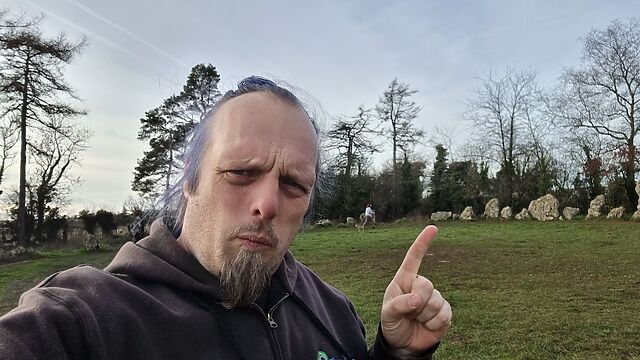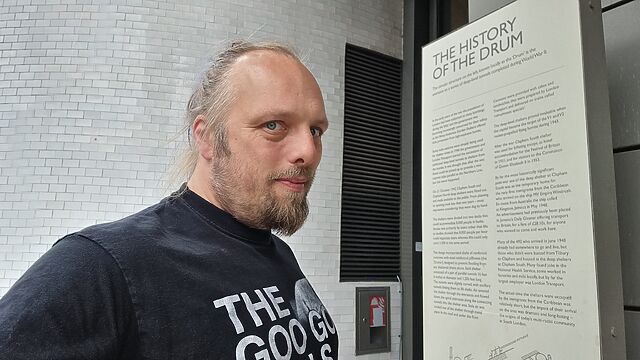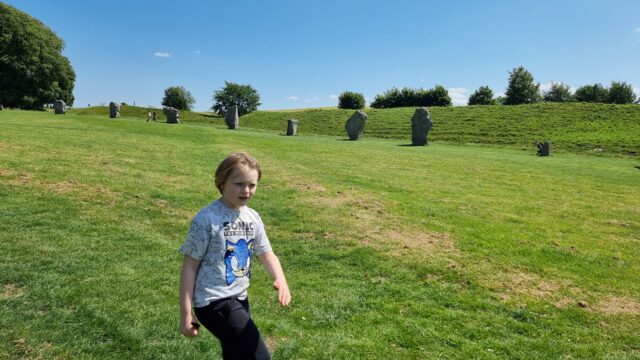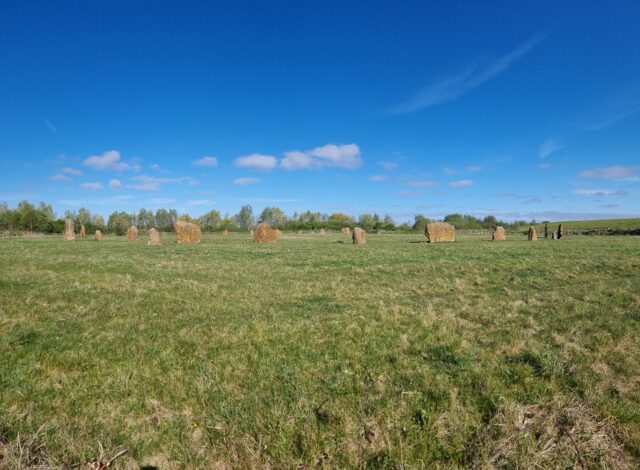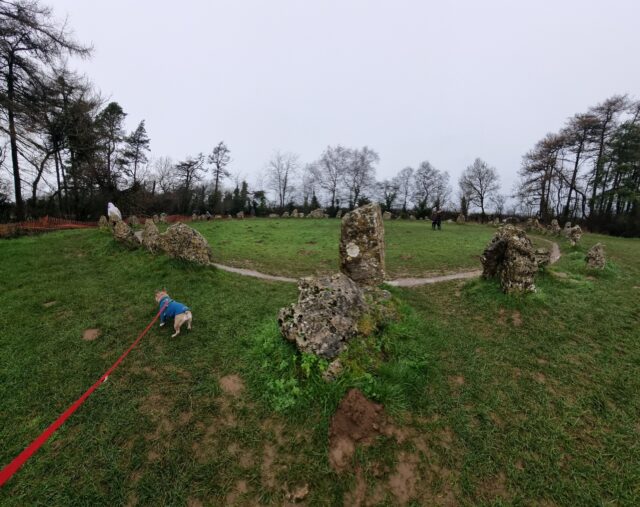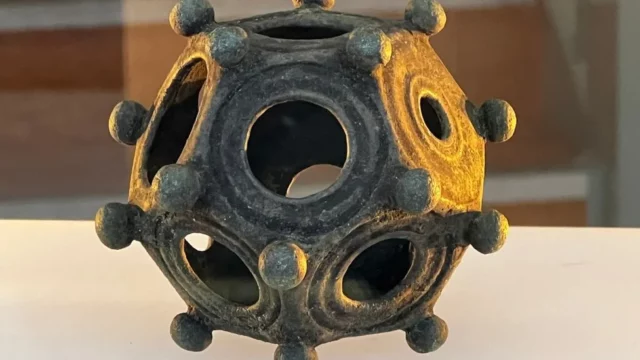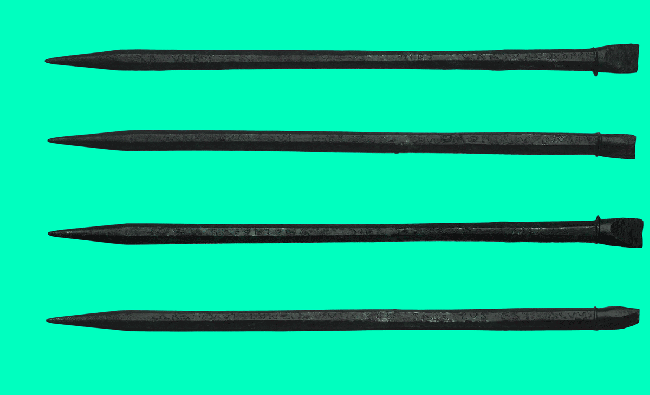Tintern Abbey’s looking especially beautiful in the fresh snow, this morning.
Tag: archeology
Note #27831
Back at the Rollright Stones fire New Year’s Day, per family tradition. This year the younger child counted 74, the elder 59. The curse that prevents you counting the same number twice continues!
Clapham South Deep Shelter
At the weekend, JTA and I – along with our eldest child – explored the Clapham South Deep Shelter as part of one of Hidden London‘s underground tours, and it was pretty great!
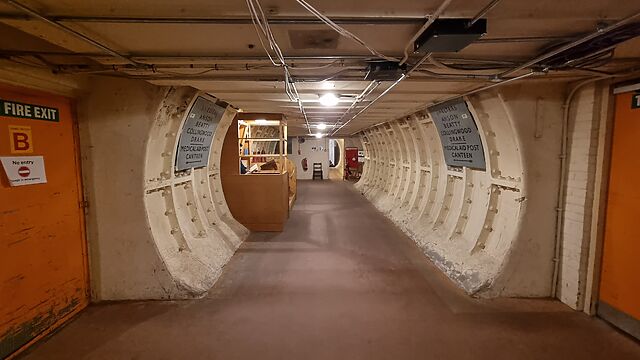
I’ve done a couple of bits of exploration of subterranean London before: in the service tunnels around Euston, and into the abandoned station on the Aldwych branch line. But I was especially impressed by the care and attention that had gone into making this particular tour fun and engaging.
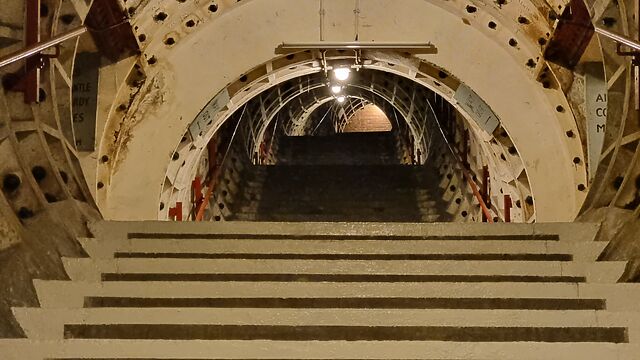
The site itself is deep: trains on the Northern Line – already one of the deepest lines on the London Underground – can be heard passing above you, and any noise from street level is completely gone (even the sounds of bombing couldn’t be heard down here, WWII residents reported). It’s also huge: long interconnected tunnels provided space for 8,000 beds, plus canteens, offices, toilets, medical bays, and other supporting architecture.

To extend the immersion of the theme even further, there’s a “warden” on-site who – after your 179-step descent – welcomes you and checks your (replica) night admission ticket, identifying which bed’s bed assigned to you. The warden accompanies your group around, staying in-character as you step through different eras of the history of the place! By the time you get to the interpretative space about the final days of its use for human habitation – as a budget hotel for the “Festival of Britain” national exhibition in 1951 – he speaks fondly of his time as its warden here and wonders about what will become of the place.
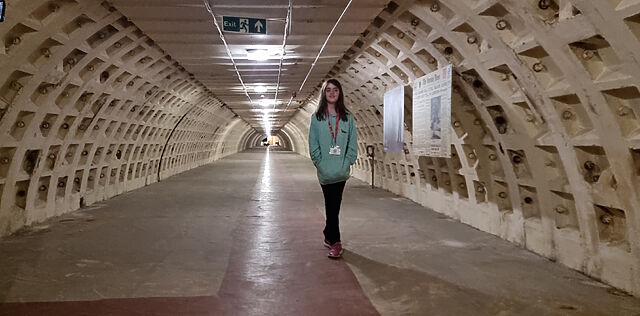
All of which is to say that this was a highly-enjoyable opportunity to explore yet another hidden place sprawling beneath London. The Hidden London folks continue to impress.
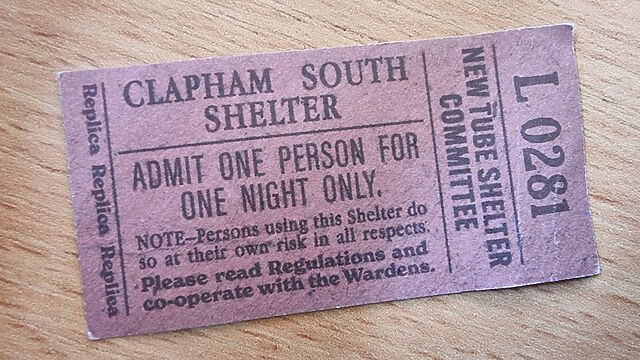
If you want to see a little more, they’ve released a video just yesterday: or for the full experience, see if there are any slots you can make to visit the place for yourself.
Note #26938
The Local Historian
Back in 2021, as part of a course I was doing at work, I made a video talking about The Devil’s Quoits, a henge and stone circle near where I live.
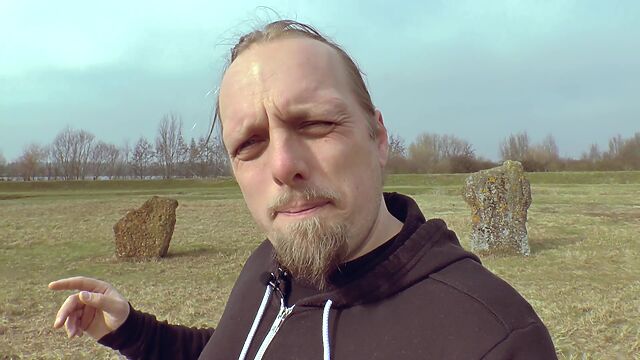
Two years later, our eldest was at school and her class was studying the stone age. Each of three groups were tasked with researching a particular neolithic monument, and our eldest was surprised when she heard my voice coming from a laptop elsewhere in the class. One of her classmates had, in their research into the Quoits, come across my video.
And so when their teacher arranged for a school trip to the Devil’s Quoits, she asked if I could go along as a “local expert”. And so I did.
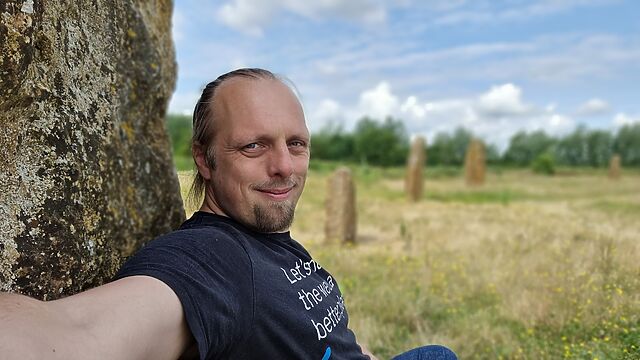
And so this year, when another class – this time featuring our youngest – went on a similar school trip, the school asked me to go along again.
I’d tweaked my intro a bit – to pivot from talking about the archaeology to talking about the human stories in the history of the place – and it went down well: the children raised excellent observations and intelligent questions1, and clearly took a lot away from their visit. As a bonus, our visit falling shortly after the summer solstice meant that local neopagans had left a variety of curious offerings – mostly pebbles painted with runes – that the kids enjoyed finding (though of course I asked them to put each back where they were found afterwards).
But the most heartwarming moment came when I later received an amazing handmade card, to which several members of the class had contributed:

I don’t know if I’ll be free to help out again in another two years, if they do it again2: perhaps I should record a longer video, with a classroom focus, that shares everything I know about The Devil’s Quoits.
But I’ll certainly keep a fond memory of this (and the previous) time I got to go on such a fun school trip, and to be an (alleged) expert about a place whose history I find so interesting!
Footnotes
1 Not every question the children asked was the smartest, but every one was gold. One asked “is it possible aliens did it?” Another asked, “how old are you?”, which I can only assume was an effort to check if I remembered when this 5,000-year-old hengiform monument was being constructed…
2 By lucky coincidence, this year’s trip fell during a period that I was between jobs, and so I was very available, but that might not be the case in future!
Note #26759
Easter Sunday Stone Circle
Note #25428
The Eyebrow Painter
This is a repost promoting content originally published elsewhere. See more things Dan's reposted.
…
There are a whole bunch of things that could be the source for the name, e.g. where we found most of their work (The Dipylon Master) or the potter with whom they worked (the Amasis Painter), a favourite theme (The Athena Painter), the Museum that ended up with the most famous thing they did (The Berlin Painter) or a notable aspect of their style. Like, say, The Eyebrow Painter.
Just excellent.
A frowning fish, painted onto a plate, surely makes for the best funerary offering.
Roman object that baffled experts to go on show at Lincoln Museum
This is a repost promoting content originally published elsewhere. See more things Dan's reposted.
A mysterious Roman artefact found during an amateur archaeological dig is going on public display in Lincolnshire for the first time.
The object is one of only 33 dodecahedrons found in Britain, and the first to have been discovered in the Midlands.
…
I learned about these… things… from this BBC News story and I’m just gobsmacked. Seriously: what is this thing?
This isn’t a unique example. 33 have been found in Britain, but these strange Roman artefacts turn up all over Europe: we’ve found hundreds of them.
It doesn’t look like they were something that you’d find in any Roman-era household, but they seem to be common enough that if you wandered around third century Northern Europe with one for a week or so you’d surely be able to find somebody who could explain them to you. And yet we don’t know why.
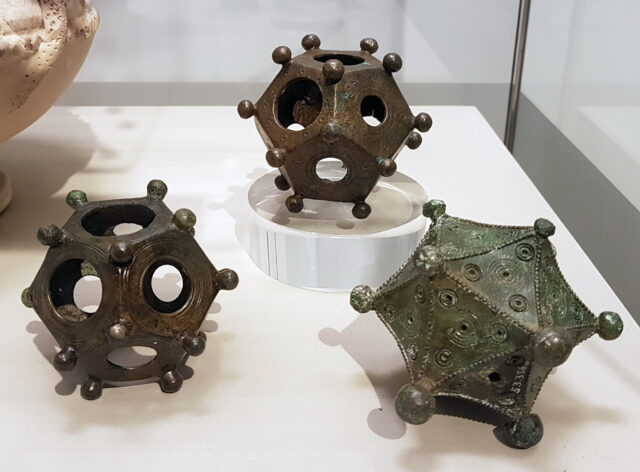
We have absolutely no idea why the Romans made these things. They’re finely and carefully created from bronze, and we find them buried in coin stashes, which suggests that they were valuable and important. But for what? Frustrated archaeologists have come up with all kinds of terrible ideas:
- Maybe they were a weapon, like the ball of a mace or something to be flung from a sling? Nope; they’re not really heavy enough.
- At least one was discovered near a bone staff, so it might have been a decorative scepter? But that doesn’t really go any distance to explaining the unusual shape, even if true (nor does it rule out the possibility of it being some kind of handled tool).
- Perhaps they were a rangefinding tool, where a pair of opposing holes line up only when you’re a particular distance from the tool? If a target of a known size fills the opposite hole in your vision, its distance must be a specific multiple of your distance to the tool. But that seems unlikely because we’ve never found any markings on these that would show which side you were using; also the devices aren’t consistently-sized.
- Roleplayers might notice the similarity to polyhedral dice: maybe they were a game? But the differing-sized holes make them pretty crap dice (researchers have tried), and Romans seemed to favour cubic dice anyway. They’re somewhat too intricate and complex to be good candidates for children’s toys.
- They could be some kind of magical or divination tool, which would apparently fit with the kinds of fortune-telling mysticism believed to be common to the cultures at the sites where they’re found. Do the sides and holes correspond to the zodiac or have some other astrological significance?
- Perhaps it was entirely decorative? Gold beads of a surprisingly-similar design have been found as far away as Cambodia, well outside the reach of the Roman Empire, which might suggest a continuing tradition of an earlier precursor dodecahedron!
- This author thinks they might have acted as a kind of calendar, used for measuring the height of the midday sun by observing way its beam is cast through a pair of holes when the tool is placed on a surface and used to determine when winter grains should be planted.
- Using replicas, some folks online have demonstrated how they could have been used as a knitting tool for making the fingers of gloves using a technique called “spool knitting”. But this knitting technique isn’t believed to have been invented until a millennium later than the youngest of these devices.
- Others have proposed that they were a proof of qualification: something a master metalsmith would construct in order to show that they were capable of casting a complex and intricate object.
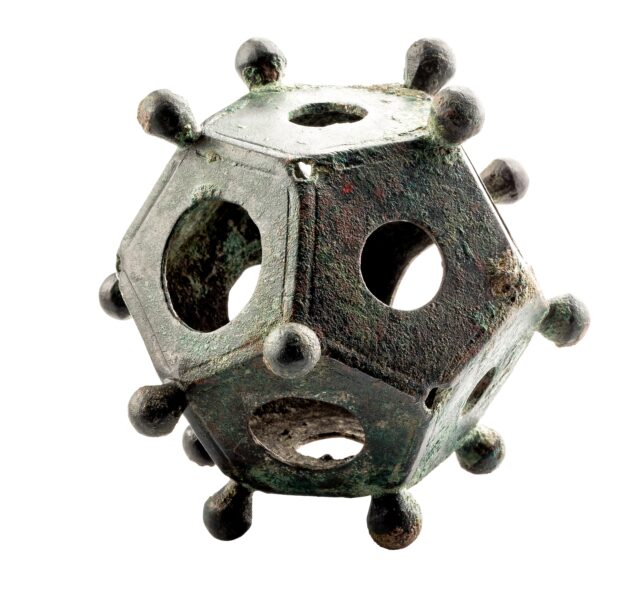
I love a good archaeological mystery. We might never know why the Romans made these things, but reading clever people’s speculations about them is great.
The Devil’s Quoits
I’ve been doing a course provided through work to try to improve my ability to connect with an audience over video. For one of my assignments in this, my fourth week, I picked a topic out from the “welcome” survey I filled out when I first started the course. The topic: the Devil’s Quoits. This stone circle – not far from my new house – has such a bizarre history of construction, demolition, and reconstruction… as well as a fun folk myth about its creation… that I’d thought it’d make a great follow-up to my previous “local history” piece, Oxford’s Long-Lost Zoo. I’d already hidden a “virtual” geocache at the henge, as I previously did for the zoo: a video seemed like the next logical step.
My brief required that the video be only about a minute long, which presented its own challenge in cutting down the story I’d like to tell to a bare minimum. Then on top of that, it took me at least eight takes until I was confident that I’d have one I was happy with, and there’s still things I’d do differently if I did it again (including a better windbreak on my lapel mic, and timing my takes for when geese weren’t honking their way past overhead!).
In any case: part of the ritual of this particular course encourages you to “make videos… as if people will see them”, and I’ve been taking that seriously! Firstly, I’ve been sharing many of my videos with others either at work or on my blog, like the one about how GPS works or the one about the secret of magic. Secondly, I’ve been doing “extra credit” by recording many of my daily-standup messages as videos, in addition to providing them through our usual Slack bot.
Anyway, the short of it is: you’re among the folks who get to see this one. Also available on YouTube.
Ancient Roman ‘Pen’ Was a Joke Souvenir
This is a repost promoting content originally published elsewhere. See more things Dan's reposted.
The tradition of buying cheap, joke souvenirs for your loved ones while travelling dates back at least two millennia.
During an archaeological excavation at a Roman-era site in London, researchers found around 200 iron styluses used for writing on wax-filled wooden tablets. One of those styluses, which just debuted in its first public exhibition, holds a message written in tiny lettering along its sides. The inscription’s sentiment, according to the researchers who translated it, is essentially, “I went to Rome and all I got you was this pen.”
…
Also found in this excavation, I assume, were t-shirts printed with “I ❤ Pompeii” and moneyboxes in the shape of the Parthenon.
Note #11210
Notes from #musetech18 presentations (with a strong “collaboration” theme). Note that these are “live notes” first-and-foremost for my own use and so are probably full of typos. Sorry.
Matt Locke (StoryThings, @matlocke):
- Over the last 100 years, proportional total advertising revenue has been stolen from newspapers by radio, then television: scheduled media that is experienced simultaneously. But we see a recent drift in “patterns of attention” towards the Internet. (Schedulers, not producers, hold the power in radio/television.)
- The new attention “spectrum” includes things that aren’t “20-60 minutes” (which has historically been dominated by TV) nor “1-3 hours” (which has been film), but now there are shorter and longer forms of popular medium, from tweets and blog posts (very short) to livestreams and binging (very long). To gather the full spectrum of attention, we need to span these spectra.
- Rhythm is the traditions and patterns of how work is done in your industry, sector, platforms and supply chains. You need to understand this to be most-effective (but this is hard to see from the inside: newcomers are helpful). In broadcast television as a medium, the schedules dictate the rhythms… in traditional print publishing, the major book festivals and “blockbuster release” cycles dominate the rhythm.
- Then how do we collaborate with organisations not in our sector (i.e. with different rhythms)? There are several approaches, but think about the rhythmic impact.
Lizzy Bullock (English Heritage, @lizzybethness):
- g.co/englishheritage
- Partnered with Google Arts & Heritage; Google’s first single-partner project and also their first project with a multi-site organisation.
- This kind of tech can be used to increase access (e.g. street view of closed sites) and also support curatorial/research aims (e.g. ultra-high-resolution photography).
- Aside from the tech access, working with a big company like Google provides basically “free” PR. In combination, these benefits boost reach.
- Learnings: prepare to work hard and fast, multi-site projects are a logistical nightmare, you will need help, stay organised and get recordkeeping/planning in place early, be aware that there’ll be things you can’t control (e.g. off-brand PR produced by the partner), don’t be afraid to stand your ground where you know your content better.
- Decide what successw looks like at the outset and with all relevant stakeholders involved, so that you can stay on course. Make sure the project is integrated into contributors’ work streams.
Daria Cybulska (Wikimedia UK, @DCybulska):
- Collaborative work via Wikimedians-in-residence not only provides a boost to open content but involves engagement with staff and opens further partnership opportunities.
- Your audience is already using Wikipedia: reaching out via Wikipedia provides new ways to engage with them – see it as a medium as well as a platform.
- Wikimedians-in-residence, being “external”, are great motivators to agitate processes and promote healthy change in your organisation.
Creative Collaborations ([1] Kate Noble @kateinoble, Ina Pruegel @3today, [2] Joanna Salter, [3] Michal Cudrnak, Johnathan Prior):
- Digital making (learning about technology through making with it) can link museums with “maker culture”. Cambridge museums (Zoology, Fitzwilliam) used a “Maker in Residence” programme and promoted “family workshops” and worked with primary schools. Staff learned-as-they-went and delivered training that they’d just done themselves (which fits maker culture thinking). Unexpected outcomes included interest from staff and discovery of “hidden” resources around the museums, and the provision of valuable role models to participants. Tips: find allies, be ambitious and playful, and take risks.
- National Maritime Museum Greenwich/National Maritime Museum – “re.think” aimed to engage public with emotive topics and physically-interactive exhibits. Digital wing allowed leaving of connections/memories, voting on hot issues, etc. This leads to a model in which visitors are actively engaged in shaping the future display (and interpretation) of exhibitions. Stefanie Posavec appointed as a data artist in residence.
- SoundWalk Strazky at Slovak National Gallery: audio-geography soundwalks as an immersive experiential exhibition; can be done relatively cheaply, at the basic end. Telling fictional stories (based on reality) can help engage visitors with content (in this case, recreating scenes from artists’ lives). Interlingual challenges. Delivery via Phonegap app which provides map and audio at “spots”; with a simple design that discourages staring-at-the-screen (only use digital to improve access to content!).
Lightning talks:
- Maritime Museum Greenwich: wanted to find out how people engage with objects – we added both a museum interpretation and a community message to each object. Highly-observational testing helped see how hundreds of people engage with content. Lesson: curators are not good judges of how their stuff will be received; audience ownership is amazing. Be reactive. Visitors don’t mind being testers of super-rough paper-based designs.
- Nordic Museum / Swedish National Heritage Board explored Generous Interfaces: show first, don’t ask, rich overviews, interobject relationships, encourage exploration etc. (Whitelaw, 2012). Open data + open source + design sprints (with coding in between) + lots of testing = a collaborative process. Use testing to decide between sorting OR filtering; not both! As a bonus, generous interfaces encourage finding of data errors. bit.ly/2CNsNna
- IWM on the centenary of WWI: thinking about continuing the crowdsourcing begun by the IWM’s original mission. Millions of assets have been created by users. Highly-collaborative mechanism to explore, contribute to, and share a data space.
- Lauren Bassam (@lswbassam) on LGBT History and co-opting of Instagram as an archival space: Instagram is an unconventional archival source, but provides a few benefits in collaboration and engagement management, and serves as a viable platform for stories that are hard to tell using the collections in conventional archives. A suitably-engaged community can take pride in their accuracy and their research cred, whether or not you strictly approve of their use of the term “archivist”. With closed stacks, we sometimes forget how important engagement, touch, exploration and play can be.
- Owen Gower (@owentg) from Dr. Jenner’s House Museum and Garden: they received EU REVEAL funding to look at VR as an engagement tool. Their game is for PSVR and has a commercial release. The objects that interested the game designers the most weren’t necessarily those which the curators might have chosen. Don’t let your designers get carried away and fill the game with e.g. zombies. But work with them, and your designers can help you find not only new ways to tell stories, but new stories you didn’t know you could tell. Don’t be afraid to use cheap/student developers!
- Rebecca Kahm @rebamex from Pelagios Commons (@Pelagiosproject): the problem with linked data is that it’s hard to show its value to end users (or even show museums “what you can do” with it). Coins have great linked data, in collections. Peripleo was used to implement a sort-of “reverse Indiana Jones”: players try to recover information to find where an artefact belongs.
- Jon Pratty: There are lots of useful services (Flickr, Storify etc.) and many are free (which is great)… but this produces problems for us in terms of the long-term life of our online content, not to mention the ethical issues with using services whose business model is built on trading personal data of our users. [Editor’s note: everything being talked about here is the stuff that the Indieweb movement have been working on for some time!] We need to de-siloise and de-centralise our content and services. redecentralize.org? responsibledata.io?
In-House Collaboration and the State of the Sector:
- Rosie Cardiff @RosieCardiff, Serpentine Galleries on Mobile Tours. Delivered as web application via captive WiFi hotspot. Technical challenges were significant for a relatively small digital team, and there was some apprehension among frontline staff. As a result of these and other problems, the mobile tours were underused. Ideas to overcome barriers: report successes and feedback, reuse content cross-channel, fix bugs ASAP, invite dialogue. Interesting that they’ve gained a print guides off the back of the the digital. Learn lessons and relaunch.
- Sarah Younaf @sarahyounas, Tyne & Wear Museums. Digital’s job is to ask the questions the museum wouldn’t normally ask, i.e. experimentation (with a human-centric bias). Digital is quietly, by its nature, “given permission” to take risks. Consider establishing relationships with (and inviting-in) people who will/want to do “mashups” or find alternative uses for your content; get those conversations going about collections access. Experimental Try-New-Things afternoons had value but this didn’t directly translate into ideas-from-the-bottom, perhaps as a result of a lack of confidence, a requirement for fully-formed ideas, or a heavy form in the application process for investment in new initiatives. Remember you can’t change everyone, but find champions and encourage participation!
- Kati Price @katiprice on Structuring for Digital Success in GLAM. Study showed that technical leadership and digital management/analysis is rated as vital, yet they’re also underrepresented. Ambitions routinely outstrip budgets. Assumptions about what digital teams “look” like from an org-chart perspective don’t cover the full diversity: digital teams look very different from one another! Forrester Research model of Digital Maturity seems to be the closest measure of digital maturity in GLAM institutions, but has flaws (mostly relating to its focus in the commercial sector): what’s interesting is that digital maturity seems to correlate to structure – decentralised less mature than centralised less mature than hub-and-spoke less mature than holistic.
- Jennifer Wexler, Daniel Pett, Chiara Bonacchi on Diversifying Museum Audiences through Participation and stuff. Crowdsourcing boring data entry tasks is sometimes easier than asking staff to do it, amazingly. For success, make sure you get institutional buy-in and get press on board. Also: make sure that the resulting data is open so everybody can explore it. Crowdsourcing is not implicitly democratisating, but it leads to the production of data that can be. 3D prints (made from 3D cutouts generated by crowdsourcing) are a useful accessibility feature for bringing a collection to blind or partially-sighted visitors, for example. Think about your audiences: kids might love your hip VR, but if their parents hate it then you still need a way to engage with them!
People don’t change
This is a repost promoting content originally published elsewhere. See more things Dan's reposted.
Fundamentally, people haven’t changed much in tens of thousands of years. If ancient Egyptians had smartphones, you know full well that they’d have been posting cat pictures too. What can we learn from this and how should we look at our role when developing front-end Web experiences?
Cropmarks 2018
This is a repost promoting content originally published elsewhere. See more things Dan's reposted.
The unprecedented spell of hot, dry weather across Wales has provided perfect conditions for archaeological aerial photography. As the drought has persisted across Wales, scores of long-buried archaeological sites have been revealed once again as ‘cropmarks’, or patterns of growth in ripening crops and parched grasslands. The Royal Commission’s aerial investigator Dr Toby Driver has been busy in the skies across mid and south Wales over the last week documenting known sites in the dry conditions, but also discovering hitherto lost monuments. With the drought expected to last at least another two weeks Toby will be surveying right across north and south Wales in a light aircraft to permanently record these discoveries for the National Monuments Record of Wales, before thunderstorms and rain wash away the markings until the next dry summer.
…

